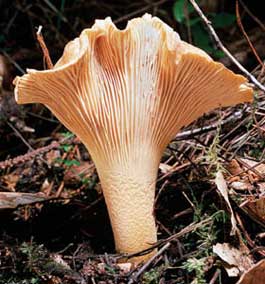home | metro santa cruz index | features | santa cruz | feature story

Photograph by Taylor F. Lockwood
Fungus Among Us: Who knew that something so tasty could be deadly, too?
The Fantastic Fungi
As the annual Fungus Fair approaches, be warned: bold mushroom gatherers don't always grow old
By Tessa Brunton
Phil Carpenter is red-green color blind. He is also an expert at identifying mushrooms, which is remarkable, considering that the differences between a fatally poisonous mushroom and an edible mushroom that goes nicely with salad greens are subtle. Yet Carpenter has mushroom smarts. As he strolls through the woods with a gathering basket that smells of Candy Caps, he names and describes the properties of every mushroom he finds.
Carpenter is also coordinating the upcoming Fungus Fair, where he will work at the mushroom identification booth next to displays of fungi with exquisite names like Poison Pies, Witch's Butter, Turkey Tails and numerous LBMs (Little Brown Mushrooms). Preparation for this fair is remarkable. Unable to grow the mushrooms for the fair's display, Carpenter and some 250 volunteers from the Santa Cruz Fungus Federation (whose motto is "When it Rains, it Spores") will spend three days in the wilds of the Santa Cruz Mountains, where they will collect and identify hundreds of wild mushrooms for the fair.
So, how do fungophiles tell mushrooms apart? As it happens, identification is extremely tricky. Some mushrooms smell of bleach, others of sweet corn. Some are coated with slime; some produce a milky liquid. The majority are not edible.
"Or if they were, why would you want to eat them?" says Carpenter. "They taste like sawdust soaked in kerosene."
Even with careful examination and comparison with a field guide, mistakes happen. Those mistakes can easily send an unfortunate taster to the emergency room. Extremely deadly mushrooms like Death Caps and Destroying Angels are particularly common in the Santa Cruz Mountains.
"People spend days at [Stanford University Medical Center]," Carpenter observes. "Death Caps destroy your liver, so you drown in your own poisons, usually in about three days. One bite puts you in the hospital. It's a slow, lingering death, painful and horrible." Carpenter has been called to emergency rooms numerous times to identify mushrooms that have been ingested.
"There was a bad year when a rumor went around that all Amanitas were hallucinogens," Carpenter recalls. While a few mushrooms of the Amanita genus have hallucinogenic properties, many of them are poisonous, and the genus includes Death Caps. As Carpenter notes, "Amanitas are an interesting genus because you can go from incredibly deadly to incredibly delicious, there's amazing variety. Apparently the deadly ones do taste good."
The worst case Carpenter witnessed happened several years ago. He received a call at 9am on New Year's Day from a couple that had mistakenly shared a bag of Death Caps, believing them to be edible. They were violently ill and Carpenter recommended an ambulance. The couple were airlifted to Stanford where they spent time in intensive care before recovering. Carpenter said, "As far as I know they had no lasting health concerns. I talked to them a year later. The guy volunteered to describe his experience at the Fungus Fair."
32nd Annual Fungus Fair, 10am-5pm, Jan. 14-15. Louden Nelson Community Center, 301 Center St., Santa Cruz. Admission $4-$6, kids 12 and under free. 831.420.6115.
Send a letter to the editor about this story.